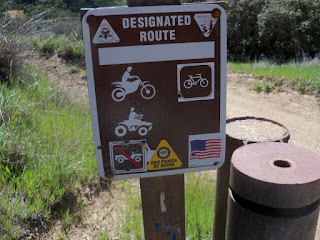Recent Pre-Event Recon for May Volunteer Project
Upper Lake Ranger District, Mendocino NF
QWR believes that substantive federal trail-based
volunteer programs don’t happen by accident.
The success of any volunteer program is directly related
to agency and user commitment to both the process and the product.
QWR understands that agency volunteer programs are simply
just one tenet (albeit an important factor) of managed recreation on a Forest Service or BLM unit.
Field Recon with Local Club Representative from
Marin County Motorcycle Association
One aspect of user involvement is to participate with the
agency on pre-planning for any large volunteer work project(s). Often that pre-event planning requires
meetings with recreation staff to review material needs for products such as
cement, barriers, signs, tables, building materials, etc.
With reduced amounts of federally appropriated funds for
recreation projects, there can be a role for users to play by helping secure
construction materials via state or industry grants or private donations.
One key planning tool is for OHV leaders to do a pre-event
field-level recon of the project to ascertain the number of volunteers required
and which specific skillsets/tools are needed to help the agency accomplish the task.
In areas where the agency is just beginning to staff up
with recreation specialists, it will be important for trail enthusiasts to reach
out to new FS/BLM staff. Riders should
invite agency leads to attend club meetings or go out for a tour of the area in
OHVs.
It has been QWR’s experience that agency recreation staff
are more than willing to go out in the field with the OHV community to discuss
trail management, solutions to resource issues, and potential future projects.
A field trip not only gives them an excuse to get out of
the office but it is an important method by which both parties can build mutual
trust and respect.
There is a lot of truth to our trail motto which is: The
quality of the unit’s trail program is directly proportional to the quality of
the relationship that exists between the agency staff and user community.













